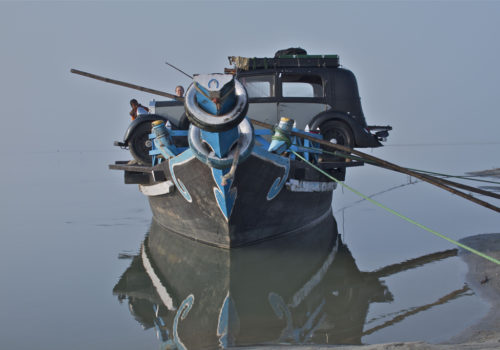The Buriganda party, a broken exhaust pipe and a new role for algorythms.
This is the coldest winter in Bangladesh since 1971.At The Chobi Mela Buriganga party, most are shrouded in blankets,and wander around the deck with an early morning coffee in one hand and camera in the other. Little sleep has been had, and we are all absorbed in watching the river coming to life in the dawn light.
I sit on a plastic chair bolted to the deck beside a providentially placed plastic table outside my cabin door. Clearly it was just waiting for someone to sit down and write a blog on a lap-top, so here it is. I look up from it to observe steel-hulled cargo boats sunk low, the Buriganga waters lapping over their gunwales so they look like moving shipwrecks chugging beside us, sleek timber-built fishing craft dancing over bow-waves and tiny figures toiling in brickyards just visible through the sunshine-bright mist. Thetall chimneys of giant kilns stand guard in random rows on the banks.
Opening celebrations of great festivals mark, as this one does, the end of the rehearsals and the beginning of action.. Today the first exhibition opens, the first artist talks are heard, and the business of presenting, discussing, and re-arranging old perceptions gets under way.
This is my 5th such river-gathering. It is a much-loved tradition of Chobi Mela, the biennial moment when old friendships are re-established, new connections made and new thinking fertilized. Saif Islam, at his first Chobi Mela since he was appointed CEO a year ago, spoke last night of the new advisory board he and Shahidul have formed to guide Patshala in the national and international network of universities. Shahidul spoke of links with potential sponsors. Other topics emerged as the night wore on.
The rapid disappearance of the newspapers which have governed the selection and dissemination of news for the last 2 centuries was one of many: who would be the gatekeepers? Who would fund investigative journalists? Was a new phenomenon rising before our eyes – the 5th Estate, as one of us put it? What form will it take, this new non-accountable force in our lives? Will the mighty algorythm stand in for copyright? Will it defend our freedom from interference by government or will technology enable it? It was a long night. By 4 we were asleep, some in cabins, some on deck.
Pablo Bartholmew, whose exhibition Outside In, A tale of 3 Cities, opens at Drik Gallery tomorrow, has just emerged from his cabin beside me as I write. Today is the day his Padma Shree – the major award he will receive in March for services to India as a photographer – is made public. With a gruff good morning he gets out his camera and focuses on the dancing boats.
Nil Obodi, from Ghana, appeared from the next cabin. At the panel yesterday he spoke of the impact the on-line world is making on the cultural diversity of his home-continent, of the dire need for education, of his passionate belief that his countrymen must surrender the post-colonial anger that informs their politics and identity. He told me that he had started his own school in Ghana. CM may be all talk but those who come are men and women of action. His workshop is tomorrow, just after mine, and I will go straight there.
Mohammed Somji, proprietor of the Gulf Photo Plus gallery in Dubai, stopped for a moment. His agenda is the same, but set in a different context: to created a voice for concerned photographers in one of the world’s wealthiest countries. He, like so many here, came because he heard Shahidul speak and was moved by his vision.
The boat is drawing close to Sadarghat, the ancient and chaotic port of Old Dhaka. The sun has finally emerged. We are surrounded by a multitude of small craft, flat-topped wooden-decked ferries propelled across the river by a giant oar at the stern after the style of venetian gondoliers. Our boat, 5 stories of cast iron, barges its way to the ghat in Dhaka’s version of maritime dodgems.
Somewhere in the over-crowded madness buses wait to take us back to Dhanmondi, but I think I will do what I usually do after these all-night gatherings, and slide off into the narrow streets of the Old city. I am familiar with them now, and love the ancient buildings, the last traces of the city founded by the Armenians in the 16th century , hidden behind the street stalls and go-downs. History is low in Bangladesh’s priority stakes. Taiful Islam, a good friend of mine who has dedicated his life to preserving Dhaka’s heritage, is fighting a tough battle to preserve what remains.
I started this blog a couple of days ago in the back of our 1936 Rolls Royce on the way to Dhaka. It was laid up at a roadside garage, not for the first time on our journey from Mumbai, with a broken exhaust after crossing a makeshift bridge near Srimingal. 2 cheerful mechanics lay under the car as I wrote. Jan and Katherine perched on logs nearby reading, the garage boy plied us with chai spiced with cardamum. It took 3 hours to weld the exhaust pipe together and bolt it back on.
At 9 pm, after 13 hours on the road, we drew up outside Drik. Shahidul and many old friends were there to greet us, and it was the warmest of welcomes. A great number of photographs were taken by the laughter. This was a high point in our long journey across the sub-continent.
Rupert Grey, January 26th 2013
Chobi Mela – International Festival of Photography
January 25 to February 7, 2013
House 58, Road 15A (New),
Dhanmondi, Dhaka 1209
Bangladesh
















